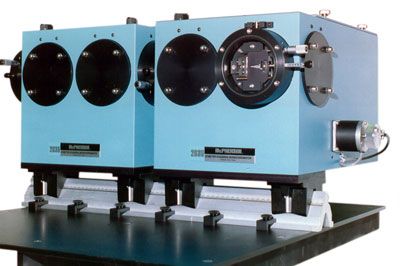
Model 2035 Double Monochromator for Additive or Subtractive Mode Operation
The Model 2035 focal length is 350-mm and the double spectrometer can be configured for additive/dual dispersion or non-additive / subtractive dispersion. Optically and mechanically coupled Czerny-Turner spectrometers are equipped with choice of ruled or holographic gratings to suit the application. Spectrally agile, the model 2035D features an all first surface optical system (Al+MgF2 coatings) for complete UV-VIS-NIR response.
| Optical Design | Czerny-Turner Monochromator / Spectrometer |
| Focal Length | 350mm |
| Aperture Ratio | f/4.8 (NA 0.1) |
| Wavelength Range | refer to grating of interest for range |
| Wavelength Accuracy | +/-0.2-nm (on counter, with 1200 G/mm grating) |
| Wavelength Reproducibility | +/- 0.005 nm (with 1200 G/mm grating) |
| Grating Size | 68 x 68mm, with turret or single grating holder |
| Slit Locations | Axial and lateral with optional extra entrance and exit port selection mirrors |
| Focal Plane | 25mm, multiply Dispersion by detector width to solve simultaneous range |
| Grating Groove Density (g/mm) | 3600 | 2400 | 1800 | 1200 | 600 | 300 | 150 | 75 | 50 |
| Spectral Resolution at 312.6nm (nm, FWHM) | 0.02 | 0.03 | 0.04 | 0.05 | 0.1 | 0.2 | 0.4 | 0.8 | 1.2 |
| Reciprocal Linear Dispersion (nm/mm) | 0.66 | 1 | 1.3 | 2 | 4 | 8 | 16 | 32 | 48 |
| Wavelength Range from 185nm to * | 430nm | 650nm | 860nm | 1.3 um | 2.6 um | 5.2 um | 10.4 um | 20.8 um | 31.2 um |
| First Order Littrow Blaze (nm) | 200nm | 240nm | Holo | 250nm | 300nm | 750nm | 1.25um | 2um | 45um |
| 240nm | 300nm | 300nm | 500nm | 1.0um | 2.5um | 3.0um | |||
| Holo | Holo | 500nm | 750nm | 3.0um | 4.0um | 8.0um | |||
| 750nm | 1.0um | 4.0um | 6.0um | 10um | |||||
| 1.0um | 1.85um | 8um | 12um | ||||||